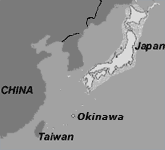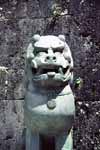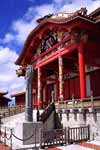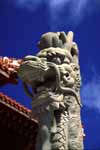
Goju-ryu - one of the traditional single combats, originating from ancient systems of a southern monastery a Shaolin. During distribution of this style to the world the various associations including in the name the term " goju-ryu" were formed some. Not applying for the legal rights of these organizations, it would be desirable to bring some clearness in a real state of affairs. For this purpose we shall address to history of development goju-ryu and Karate in general. The matter is that now karate has acquired a lot of legends and the hearings often inappropriate to the validity.
 First, analogy " karate - Japan " is not absolutely true, as in the beginning of 20-th century in karate not only did not practise in Japan, but also at all did not suspect about its existence. The native land in karate - Okinawa, the small island located near to Chinese province Fujan. Art Okinawa-te (оkinawan hand) was generated at 12-13 a century by merge of local receptions of hand-to-hand fight and ancient fighting systems which have been borrowed by the Okinawa seamen supporting close communications with India. Prominent feature of the Indian fighting systems was mainly use of a fist whereas in China the preference is given the open palm.
First, analogy " karate - Japan " is not absolutely true, as in the beginning of 20-th century in karate not only did not practise in Japan, but also at all did not suspect about its existence. The native land in karate - Okinawa, the small island located near to Chinese province Fujan. Art Okinawa-te (оkinawan hand) was generated at 12-13 a century by merge of local receptions of hand-to-hand fight and ancient fighting systems which have been borrowed by the Okinawa seamen supporting close communications with India. Prominent feature of the Indian fighting systems was mainly use of a fist whereas in China the preference is given the open palm.
In the further in connection with direct affinity and higher level of development, the Chinese systems have rendered huge influence on all okinawan styles. Practically any, from styles  nowadays existing on Okinawa, is delivered from China and assimilated with local system " Those ". On island always there lived a plenty of the Chinese immigrants, many of which were masters of kempo. But only some systems have received the development on Okinawa. The life here is closely connected with the sea, the output in which has always been interfaced to risk for a life. And the elements represented danger smaller, than pirates or the ships of other countries. In this connection skill to conduct fight in the closed space was vital and the preference was given the systems practising near fight.
nowadays existing on Okinawa, is delivered from China and assimilated with local system " Those ". On island always there lived a plenty of the Chinese immigrants, many of which were masters of kempo. But only some systems have received the development on Okinawa. The life here is closely connected with the sea, the output in which has always been interfaced to risk for a life. And the elements represented danger smaller, than pirates or the ships of other countries. In this connection skill to conduct fight in the closed space was vital and the preference was given the systems practising near fight.
Basis of the okinawan karate has given a push to development king Se Ha-si who in the middle of 15-th century has completely forbidden carrying the weapon. Many masters consider its Decree as very wise decision for after it in karate has risen on due height.
 In the modern literature, telling about okinawa fighting arts, the main role in their development is allocated to peasants, that, basically, incorrectly. The basic sources of the income of okinawan peasants were cultivation of rice and fishing catching. Both of process are labour-consuming enough and demanded 10-12 hours of continuous work. After such labour-consuming day on development of art of an empty hand there was no either forces, or time. Besides the judgement enough complex fighting system demands the certain level of erudition. Here then peasants have adapted various improvised means for the protection.
In the modern literature, telling about okinawa fighting arts, the main role in their development is allocated to peasants, that, basically, incorrectly. The basic sources of the income of okinawan peasants were cultivation of rice and fishing catching. Both of process are labour-consuming enough and demanded 10-12 hours of continuous work. After such labour-consuming day on development of art of an empty hand there was no either forces, or time. Besides the judgement enough complex fighting system demands the certain level of erudition. Here then peasants have adapted various improvised means for the protection.
So has arisen kobu-do - art of the subsidiary weapon, or as it call on Okinawa - karate from village. This system, alongside with a traditional stick, included such subjects, as: kama (sickle), tunfa (the adaptation for cultivation of rice), kai (trident), nunchaku, ke (oar) and some other. By the way, on Okinawa such known weapon as nunchaku is on the last, a place by efficiency. It name the weapon of one impact, and, it is considered the core skill unexpectedly to snatch out nunchaku because of a bosom or from a sleeve and, not stopping movement to amaze a target.
 So, peasants have really created effective system of self-defense in which basis laid principle on Okinawa: " the best weapon what is most close to you". Then, as “Those” were engaged in art people of mainly nobiliary origin. Any taken in a hand a stick or a stone can at desire kill the person. To make the weapon of hands, - time and enormous efforts is required. Besides it is impossible to present the nobleman practising with an oar or nunchaku (the adaptation for обмолки rice). The most part of time of the existence Okinawan Kingdom was protectorate of China, and as, everything was already marked, the styles which have generated on island, conduct the origin therefrom. Goju-ryu is not exception.
So, peasants have really created effective system of self-defense in which basis laid principle on Okinawa: " the best weapon what is most close to you". Then, as “Those” were engaged in art people of mainly nobiliary origin. Any taken in a hand a stick or a stone can at desire kill the person. To make the weapon of hands, - time and enormous efforts is required. Besides it is impossible to present the nobleman practising with an oar or nunchaku (the adaptation for обмолки rice). The most part of time of the existence Okinawan Kingdom was protectorate of China, and as, everything was already marked, the styles which have generated on island, conduct the origin therefrom. Goju-ryu is not exception.
Per 1875 the young master Okinawa-te Kаnryo Higaonna, has left for China where it was trained in current of 15 years at master Ryu Ryuko. Ryu Ryuko was the person of high growth and a dense constitution.
By means of constant exercises it has got extraordinary physical strength to what one case testifies. Once the elderly master was engaged in manufacturing bamboo stick(post). Unexpectedly the young man has rushed into the house and has caused the master on a duel. To show the force, it has taken bamboo шест and has broken it. Ryu Ryuko to which at that time was about 70 years, has easy picked up a fragment stick(post) and, having pulled it in the different parties has torn a bamboo. After such demonstration of force the young adventurer has literally thawn in air.
Family Ryu Ryuko was a nobiliary origin, but because of participation in some plots and revolts, disappeared under a mask of commoners. For uninitiated the style stored family, referred to as art of a short hand, and only elites knew the true name - " the Fist of a White Crane ". This school has been created in 16 century by the daughter was shaolin monk Van Chzeduna. Van Chzedun practised school " Tiger " and was very known master in China. Repeatedly acting on the party of validity, the master in one of skirmishes has been fatally wounded. After death of the father, its daughter Van Tsinyan, has continued the employment independently.
 Persistent employment have led to that weight Van Tsinyan has increased, and on force it surpassed many men. Its skill has increased so, that biting impact of the back party of a palm it broke the stone thrown upwards.
Persistent employment have led to that weight Van Tsinyan has increased, and on force it surpassed many men. Its skill has increased so, that biting impact of the back party of a palm it broke the stone thrown upwards.
Shortly the glory about the woman-master has extended across all China. Many experts on fighting arts tried to check up, this style is how much strong. One of them, Go Min, has arrived to province Fujan simply to get acquainted with new school as did not consider the woman as the serious opponent. But after formal exercises have been shown, it has caused Van Tsinyan on a duel which has ended very quickly with unexpected for Go Min with result. Instantly having approached, Van Tsinyan has interrupted to the opponent a femur. Having retained and having cured it, the woman-master has made the former opponent the pupil. It was the second person who is engaged " the White Crane ". The third was son Go Minya – Go Li, which after long and wearisome trainings has been named by the keeper of tradition and subsequently has developed and has transferred its pupils.
